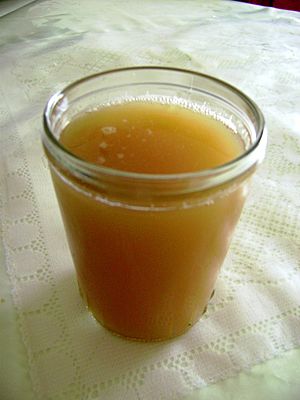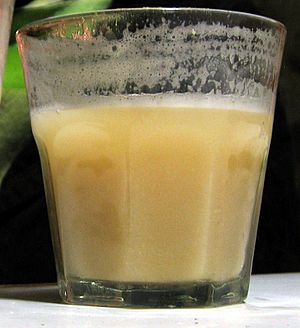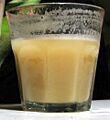Chicha de jora facts for kids

Chicha de jora is a special drink made from corn. It's a type of chicha, which is a traditional drink from the Andes mountains. To make it, people first let corn seeds start to grow, a process called germinating. This helps release natural sugars from the corn. Then, these sugars are taken out, boiled, and left to ferment. Fermenting means tiny living things (like yeast) turn the sugars into a small amount of alcohol. This process is much like how regular beer is made.
Sometimes, other ingredients like quinoa are added to make the drink thicker. A type of raw cane sugar called chancaca is also often used. It helps the fermentation process work well. Chicha de jora is usually made from a specific kind of yellow corn called jora.
The drink has a light yellow color and looks a bit cloudy, like milk. It tastes a little sour, similar to a strong apple cider. You can drink it when it's young and sweet, or when it's older and stronger. It has a small amount of alcohol, usually about 1% to 3%.
In some very old traditions, instead of germinating the corn, people would grind it up. Then, they would moisten the ground corn in their mouths and form it into small balls. These balls were flattened and left to dry. The natural enzymes in saliva helped break down the corn's starch into sugars. This method of chewing grains was used in many ancient cultures around the world to make alcoholic drinks.
What is Chicha de Jora Used For?
Chicha de jora has been made and enjoyed by communities in the Andes mountains for thousands of years. The ancient Inca people used chicha for important ceremonies and drank a lot of it during religious festivals. Places where chicha was likely made have even been found at the famous Machu Picchu site.
During the time of the Inca Empire, young women learned how to brew chicha in special schools called Aqlla Wasi.
Today, it's becoming harder to find chicha made in the traditional way. It is mostly still prepared in a few towns and villages in countries like Bolivia, Peru, Ecuador, Colombia, and Costa Rica.
However, it remains very popular in southern Peru. You can find it sold in almost every small town and in the neighborhoods of bigger cities. These places are often called 'chicherias'. They are usually just an unused room or a part of someone's home. Selling chicha can help a family earn extra money. You can spot a chicheria by a bamboo pole sticking out of an open door. This pole is often decorated with red flags, flowers, ribbons, or colored plastic bags.
Chicha is usually sold in large glasses called caporal, which are about half a liter. People drink these right there at the chicheria. You can also buy it by the liter to take home. The chicha is usually poured directly from a large earthenware pot called a chomba, where it was brewed.
In the Cuzco area of Peru, people often pour a small amount of the foamy drink onto the ground before they drink it. They say, "Pachamama, santa tierra." Pachamama means "Earth Mother" in the Quechua language, and santa tierra means "blessed ground" in Spanish. This tradition dates back to the time of the Spanish conquest. It's a way of giving the first part of the drink to Mother Earth, like a toast. This tradition is also common in the highlands of Bolivia.
Images for kids
See also
 In Spanish: Chicha de jora para niños
In Spanish: Chicha de jora para niños




